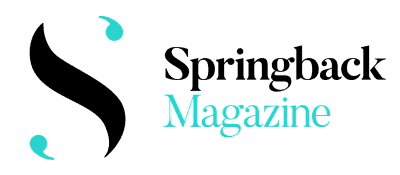Springback Academy 2022
Review

Pas de deux
Cie AMA / Anna-Marija Adomaityte
It always takes two for a pas de deux. Surrounded by the audience who is seated on stage, a couple explore what it means to dance in a duet, until exhaustion – an ongoing relationship of power.
Holding each other by the hand and core – like a back-to-front tango – the duo doesn’t face each other. The priority is to keep turning, driven by little toe bounces. A ballet fourth position emerges as they pause and get ready to restart. The torso vibrates minutely and discloses an ongoing tension: Victor Poltier takes the lead, Mélissa Guex tries to move in another direction. Distribution of power is the core of the piece, which uses repetition to rethink the roles of leading and being led.
They have been waiting for us still in the same position for a long time. He is behind her and holds her hands as if they were to share a social dance which finally begins but remains in the same spot. Under the persisting and monotonous sound of the music, he keeps on supporting her while she repeatedly twists her body as they turn around themselves. They stop only to begin once more, but this time, they rhythmically swirl their fragmented duet on the blue carpet in a dance that could be going on eternally. Unexpectedly, he lifts her in the air like a skyrocket before going back to their constant duet.
Anna-Marija Adomaityte designs a two-part choreographic structure for an audience to witness and empathise in proximity from all-around. Pas de Deux accumulates intensity and anticipation for a duet that requires deep listening to each other to coordinate the moments of intimacy, detachment and reconnection; a gentle duet of care and support in a journey of endurance.
A private salon with ceiling panel light and we are invited to sit around the blue carpet. The retro decor may suggest a classical pas de deux while the industrial sound implies the contrary. So does the posture of the dancing couple: the man stands behind the woman, hand in hand.
They begin to turn clockwise, a 10–15 degree each time. The man’s feet do not leave the floor while the woman copes with two small steps. What if you watch this tour de deux repeating for half an hour? Basically yes, but… the movement (a couple of unexpected jumps for example) also deviates round by round and the trance music’s crescendo engages the audience as much as this repetitive and machinelike movement.
The choreography turns into another direction in the end. Partners are detached, exploring face-to-face position to reconnect. Anna-Maria Adomaityte makes a stunning footprint in the history of pas de deux.
In a picture of visual polish, three lit rectangles suspend low above a royal blue carpet, framing man and woman, braced. The nucleus of their movement is a bounce, revolving on the spot, fixed in coupled form. The piece thickens through mutations on this perpetual repetition, small but loud alterations of heels, eye focus, hand grip, that torturously obfuscate the question of who is guiding who.
It’s repetition but certainly not meditation – otherwise, why do I feel so uneasy? Vast music layers itself, new sounds corroding old ones. She is alert and untrusting. He is frozen between unwillingness, and tangible fear. Only twice, she launches cuboid high, or perhaps he propels her. Deviant, she skips beats, rupturing his solidity, and a suppressed arm wrestle halts them both. As if withdrawing a Jenga block, she cautiously detaches herself.
Now facing each other, an absence of eye contact is blatant. We are thirsty for it, but they tremor as if locking eyes might detonate a bomb. The word ‘brink’ is redefined by a 40-minute threshold of preparation, that ultimately, seems more like a glitch doomed to loop eternally. Minimalism at its most infuriating, and most compelling.
Three glaring overhead lights, a bright blue square of carpet, pounding, percussive electronic music: this is the setting that greets us and that we are invited to sit closely all around. Inside the square a couple are poised, suspended in a state of tension, ready to dance. They look fragile, androgenous, almost awkward, and their suspended stillness seems to last forever.
Without warning they jerk into motion. In a hopping, repetitive jig, they mechanically rotate through each corner of their blue dance floor. Their stony expression accentuates the automaton nature of their rapport. And yet, as their fractal dance endures, each minute adjustment of the clasp of their hands, every slight shift in direction, claims our scrutiny and divulges an almost overwhelming tenderness in their shared exploit. Once and once only, he lifts her high in the air. If you blink you miss it. Abstraction, endurance and duration breathtakingly evoking the unfathomably complexity of human experience.

